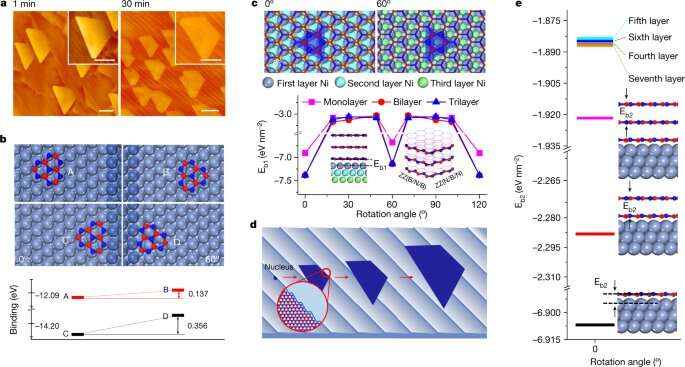June 7, 2022 report
Using chemical-vapor deposition to build five layered single-crystal hexagonal boron nitride structures

A team of researchers affiliated with multiple institutions in the Republic of Korea working with a colleague from the University of Cambridge, has developed a way to use chemical-vapor deposition to build five layered single-crystal hexagonal boron nitride structures. In their paper published in the journal Nature, the group describes their technique and possible uses for such structures. Soo Ho Choi and Soo Min Kim with Sungkyunkwan University and Sookmyung Women's University, respectively, have published a News and Views piece in the same journal issue, outlining the work done by the team on this new effort.
Over the past several years, it has become clear that a replacement needs to be found for the silicon used as a substrate in the production of a wide variety of electronic devices. As part of that effort, hexagonal boron nitride has come to be seen as a possible successor. Up to this time, however, engineers have found it difficult to grow samples that are uniform enough for use in a production environment. And using the material to create multilayered structures has proven to be even more of a challenge. In this new effort, the researchers have developed a way to overcome such problems and in so doing have demonstrated five-layered structures using the material.
The technique by the group started with changes to the traditional ways to grow hexagonal boron nitride films as a single crystal. Their method involved the use of a crystal sheet that allowed for exposing the crystallographic nickel plane during the chemical-vapor deposition process. They also found that it was critical to place the growing structure in an environment with just the right temperature for the right application. They found that temperatures of 1,120 to 1,220 °C provided the best results. In their approach, small patches of nucleate grew first—over time they grew to cover the substrate. The researchers then showed that by varying the growth rate they could grow additional layers, leading to the development of a five-layered structure. They acknowledge that controlling the thickness of each layer to ensure uniformity proved challenging.
The researchers suggest their work demonstrates that it is possible to build multi-layered single-crystal hexagonal boron nitride structures, opening up the possibility of their use in semiconductors.
More information: Kyung Yeol Ma et al, Epitaxial single-crystal hexagonal boron nitride multilayers on Ni (111), Nature (2022). DOI: 10.1038/s41586-022-04745-7
Soo Ho Choi et al, Multilayer 2D insulator shows promise for post-silicon electronics, Nature (2022). DOI: 10.1038/d41586-022-01476-7
Journal information: Nature
© 2022 Science X Network





















